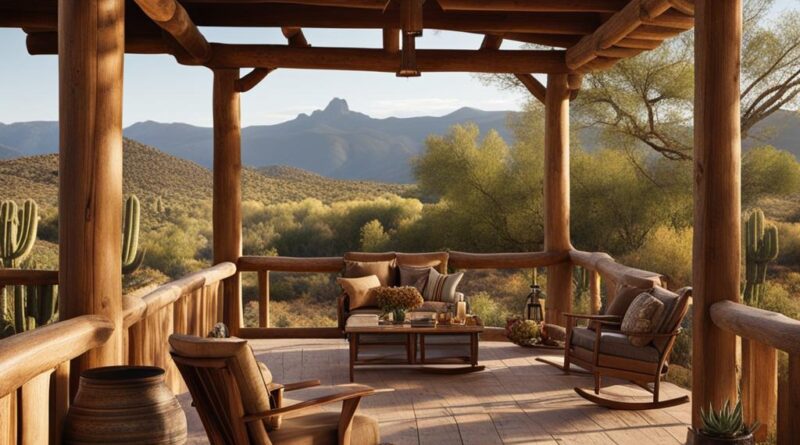Western Homes: Unique Styles & Trends in the US
Western homes in the US encompass a wide range of unique styles and trends. From rustic farmhouse designs to cozy log cabins, these homes capture the charm and essence of country living. In this article, we will explore the different types of western-style houses, along with the latest trends in Western-inspired architecture and home decor.
Key Takeaways:
- Western homes in the US offer a diverse range of architectural styles and designs.
- Rustic homes, farmhouse style homes, ranch style homes, and log cabin homes are popular choices in western home design.
- Country living and western decor are key themes in western-style houses.
- Western-inspired architecture combines traditional elements with modern influences.
- Stay tuned to discover the distinctive features and characteristics of various western home styles.
Salt Box Houses: New England Coastal Charm
Salt box houses are a distinctive style of western homes commonly found along the picturesque New England coastline. These charming houses capture the essence of coastal living and exhibit a unique architectural design that sets them apart.
The defining feature of salt box houses is their sharply slanted gable roofs, which resemble the shape of a traditional salt storage box. This roof design creates a striking visual appeal and adds character to the overall structure. The roofs typically have two stories in the front and one story in the back, giving the house its signature asymmetrical profile.
The salt box style originated in the 17th century and was commonly used by early settlers in New England. The unique roof shape allowed for maximized space and added structural stability, making these houses practical and functional.
Salt box houses have a distinct charm that reflects the maritime history and coastal lifestyle of New England. They are a testament to the ingenuity of early settlers and continue to captivate homeowners with their timeless appeal.”
Today, salt box houses continue to be popular in coastal communities, where they blend seamlessly with the natural beauty of the New England coastline. Their classic yet unique design creates an inviting and cozy atmosphere, perfect for those seeking a home with character and charm.
Key Features of Salt Box Houses:
- Sharply slanted gable roofs
- Asymmetrical profile
- Two stories in the front, one story in the back
- Reflects New England coastal charm
- Practical and functional
Experience the allure of coastal living with a salt box house, where history and charm come together to create a truly remarkable home.
Carriage Houses: Historic Elegance in Urban Areas
Carriage houses are a type of western home commonly found in urban areas, often next to or attached to standard row houses. These houses were originally built as accommodations for horses and carriages by wealthy families. They are characterized by their oversized arched center doorways and elegant architectural details. Today, many carriage houses have been converted into unique living spaces, preserving their historic charm.
Carriage houses bring a touch of old-world elegance to bustling urban areas. Their rich history and architectural beauty make them a desirable option for those seeking a blend of historic charm and modern living. With their distinctive features and unique layout, carriage houses stand out among other types of urban homes.
One of the defining characteristics of carriage houses is their oversized arched center doorways. These doors were designed to accommodate the entry and exit of horse-drawn carriages, reflecting the original purpose of these buildings. The arched doorways serve as a visual focal point and contribute to the overall elegance of the house.
In addition to the arched doorways, carriage houses often feature other architectural details that enhance their historic charm. Elaborate moldings, decorative trim, and grand staircases are just a few examples of the intricate craftsmanship that can be found in these houses. The attention to detail in the design and construction of carriage houses speaks to the wealth and status of the families who originally inhabited them.
Although carriage houses were initially built as functional spaces for horses and carriages, many have been repurposed into unique living spaces. The conversion process often involves preserving the original architectural elements while incorporating modern amenities and conveniences. This blend of old and new creates a truly distinctive living environment that pays homage to the past while meeting the needs of today’s urban dwellers.
Carriage houses offer residents a chance to live in historic settings without sacrificing the comforts of modern life. The spacious layouts and high ceilings provide a sense of grandeur, while the adaptable floor plans allow for versatile living arrangements. These homes are often sought after for their character, charm, and a connection to the past that cannot be replicated in newer constructions.
| Benefits of Carriage Houses: |
|---|
| Preservation of historic charm and architectural details |
| Unique living spaces with spacious layouts and high ceilings |
| Blend of old-world elegance and modern amenities |
| Adaptable floor plans for versatile living arrangements |
| Connection to the rich history of urban areas |
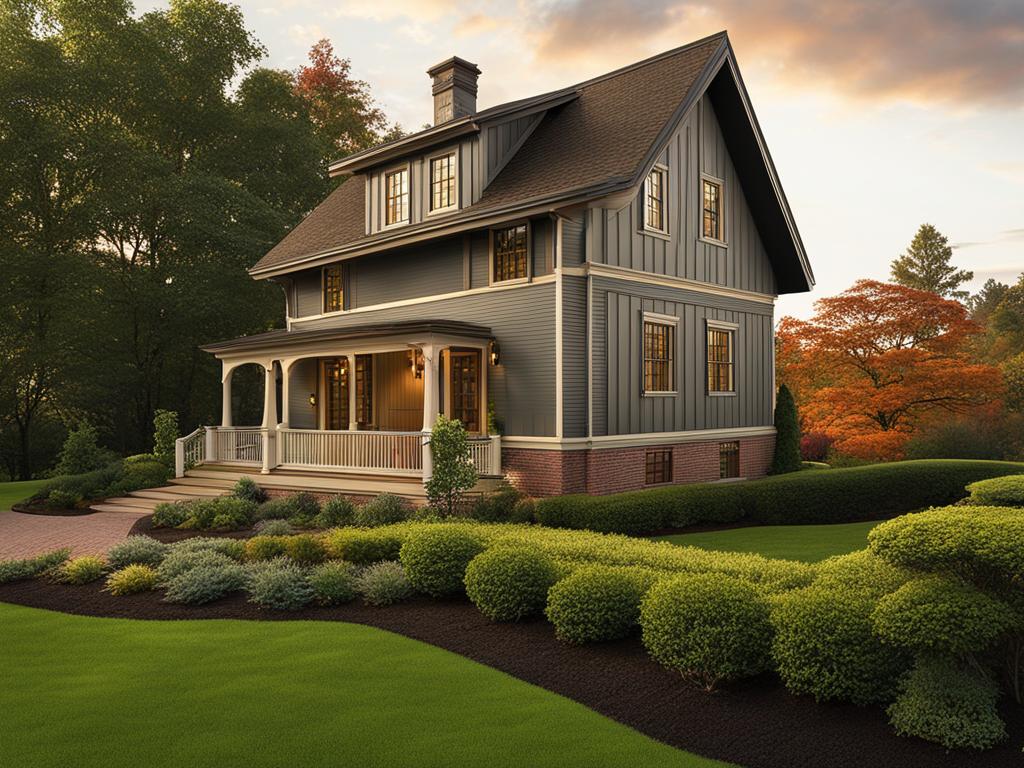
“Carriage houses are a testament to the architectural heritage of urban areas. They embody the elegance and sophistication of bygone eras while providing unique living spaces for modern residents.
Carriage houses bring a touch of historic elegance to urban areas, serving as a reminder of the rich heritage embedded within the bustling cityscape. These unique homes offer a blend of old-world charm and modern living, providing residents with a truly distinctive and enchanting living experience.
Duplexes: Versatile Living Spaces
Duplexes are a type of western home that offers versatile living options. They are standard single-family homes that have been divided into two separate units. Each unit has its own entrance and is fully equipped as a single-family home.
Duplexes are known for their symmetry, with mirrored floor plans that create balance and visual appeal. This architectural feature adds to the overall charm and aesthetic of these homes. The symmetrical design also allows for equal distribution of space and amenities between the two units.
One of the key advantages of living in a duplex is the flexibility it offers. The two separate units can cater to various living arrangements, making them suitable for families, multigenerational households, or individuals looking for rental income. It’s a great option for those seeking to live with extended family members while maintaining privacy and independence.
Moreover, duplexes are especially popular in urban settings. Their compact design makes efficient use of limited space, allowing for more housing options in densely populated areas. With their close proximity to amenities, transportation, and entertainment, duplexes provide convenience and accessibility.
Whether you’re a homeowner or an investor, duplexes can be a smart choice. They offer the benefits of homeownership with added financial advantages. Renting out one unit can generate rental income to help offset mortgage payments and expenses. It’s an excellent investment opportunity that can lead to long-term financial stability.
If you’re considering buying or building a duplex, it’s essential to work with professionals who specialize in duplex construction and design. They can help ensure that the units meet the necessary building codes, have separate utility systems, and adhere to local regulations.
“Duplexes are a versatile solution for urban living, providing efficient use of space and offering various housing arrangements while maintaining privacy. Whether you’re looking for a home to accommodate a multigenerational family or seeking an investment opportunity, duplexes offer the flexibility and convenience you need.”
To give you a better idea of the benefits and features of duplexes, here’s a comparison table:
| Duplexes | Single-Family Homes |
|---|---|
| Two separate units with individual entrances | One unit |
| Fully equipped as a single-family home | Fully equipped as a single-family home |
| Symmetrical design | Varies |
| Versatile living options | Standard living arrangement |
| Compact design suitable for urban settings | Varies |
| Potential for rental income | Varies |
As you can see, duplexes offer unique advantages and a flexible living arrangement that sets them apart from traditional single-family homes.
Tudor Style Homes: Old-World Charm with a Twist
Tudor style homes are easily recognizable by their distinctive features. They combine elements of medieval architecture with a touch of whimsy, resulting in a truly unique and charming aesthetic. These homes originated in England during the Tudor period (1485-1603) and have since become popular in the United States for their timeless appeal.
One of the defining features of Tudor style homes is decorative half-timbering. This technique involves creating a mock frame made of thin boards filled with stucco or stone. The half-timbering is often placed in a herringbone or diamond pattern, adding visual interest and sophistication to the exterior. The rest of the exterior is typically brick, enhancing the overall charm and character of the home.
The roof of a Tudor style home is another notable feature. It is steeply pitched, creating a sense of drama and grandeur. Multiple overlapping front-facing gables give the roof a distinctive silhouette and add to the overall architectural appeal. The steep pitch of the roof also serves a practical purpose, allowing for better drainage and preventing the accumulation of snow and debris.
One of the most famous examples of Tudor style architecture is Anne Hathaway’s Cottage in Stratford-upon-Avon, England. This quaint and picturesque house showcases all the characteristic elements of Tudor design, from the decorative half-timbering to the steeply pitched roof.
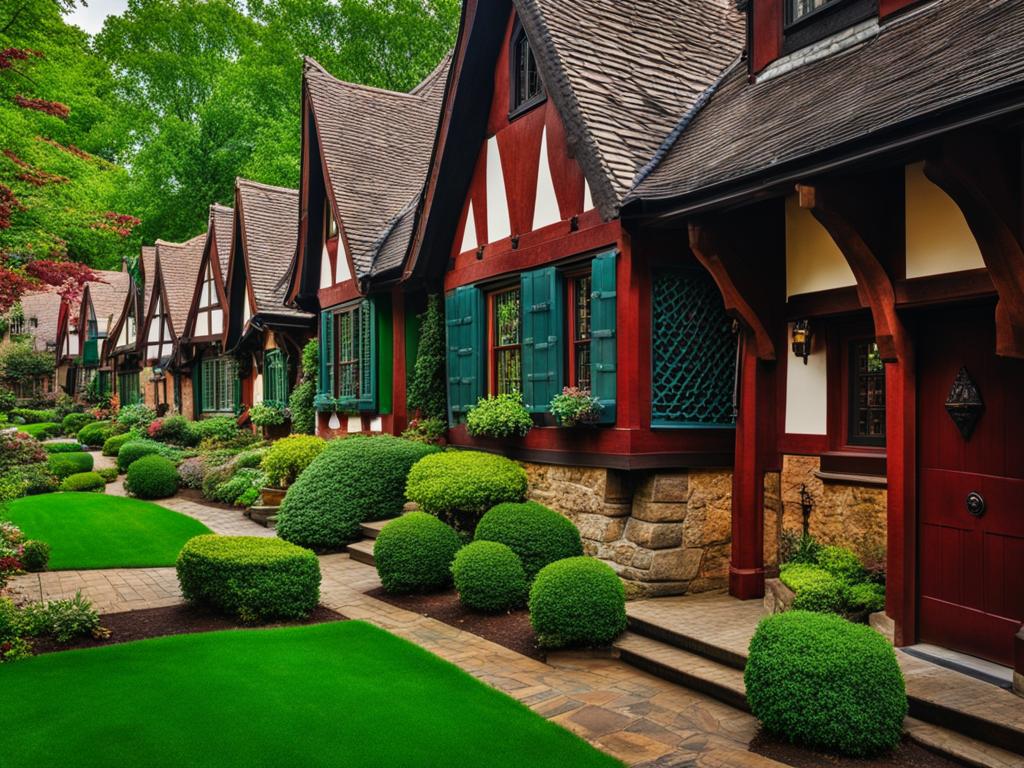
Tudor style homes bring old-world charm to modern living. Their unique architectural details and whimsical appeal make them stand out in any neighborhood. Whether you’re looking for a cozy cottage or a grand manor, Tudor style homes offer a distinctive and timeless choice for those seeking a touch of history and character in their living spaces.
Brownstone Townhouses: Timeless Elegance in Urban Settings
Brownstone townhouses are a classic type of western home that is commonly seen in cities like New York City, Boston, Philadelphia, and Washington, D.C. These homes are named after the brown sandstone used to coat their exterior, which gives them a timeless and elegant appearance. Brownstones are often multi-story buildings with unique architectural details, representing the rich history and character of urban living.
When it comes to brownstone townhouses, New York City stands out as a prime example of their prevalence and significance. These iconic homes line the streets of neighborhoods like Brooklyn Heights, Park Slope, and the Upper West Side, adding to the charm and allure of the city. Brownstone townhouses have become synonymous with urban living in New York, showcasing a blend of historical grandeur and modern convenience.
Historical Significance
Brownstone townhouses have a rich architectural and cultural history. Originating in the mid-19th century, they became popular during the Victorian era. The abundance of brownstone in the northeastern United States, particularly in New York City, allowed for the construction of these grand residences.
“Brownstone townhouses represent a significant era in New York City’s architectural evolution. They offer a glimpse into the city’s past and serve as a reminder of its rich history.”
The unique design of brownstone townhouses reflects the trends and tastes of the time. Elaborate and ornate facades, intricate moldings, and grand stoops were common features, emphasizing the social status of the occupants. The multi-story layout provided ample space for large families and luxurious living.
Architectural Features
Brownstone townhouses are characterized by their distinctive architectural features that exude elegance and sophistication. Some of the key elements include:
- Brownstone Facade: The exterior of these townhouses is adorned with brown sandstone, giving them their name. The warm hue and intricate details of the facade contribute to the overall appeal.
- Grand Stoops: Brownstone townhouses often have a grand stoop leading to the main entrance. These elevated platforms, sometimes with iron railings, add a touch of grandeur to the homes.
- High Ceilings: The interior of brownstone townhouses is characterized by high ceilings, creating a sense of spaciousness and grandeur.
- Original Architectural Details: Many brownstone townhouses have preserved their original architectural details, such as ornate moldings, intricate woodwork, and decorative fireplaces, showcasing the craftsmanship of the past.
Experiencing Urban Living
Living in a brownstone townhouse offers a unique urban experience. The combination of historic charm and contemporary amenities makes these homes highly sought after. Residents can enjoy the convenience of city living while immersing themselves in the rich cultural heritage of their neighborhood.
“Brownstone townhouses provide a sense of community and belonging. They offer residents a chance to be part of the vibrant urban fabric while enjoying the comfort and elegance of a well-preserved historic home.”
Furthermore, brownstone townhouses often boast spacious interiors, allowing for flexible living arrangements. Families can enjoy multiple floors, private outdoor spaces, and luxurious finishes that cater to their modern lifestyle needs.
The Enduring Appeal
Despite the changing landscape of urban areas, brownstone townhouses continue to captivate homeowners and visitors alike. Their timeless elegance, unique architectural details, and proximity to city amenities make them a coveted housing option in bustling urban environments.
Brownstone townhouses stand as a testament to the enduring allure of classic design and the rich history of the cities they adorn. Embracing the past while adapting to the needs of the present, these homes offer an unparalleled blend of elegance, charm, and urban living.
| Advantages of Brownstone Townhouses | Disadvantages of Brownstone Townhouses |
|---|---|
|
|
A-Frame Houses: Modern Simplicity in Northern Parts of the US
A-frame houses offer a unique and contemporary style of western living, with their distinctive triangular silhouette resembling the shape of a capital “A. These homes are most commonly found in northern parts of the US, where their sloped roofs are designed to easily shed snow and rain. A-frame houses have gained popularity for their modern and minimalist aesthetic, providing homeowners with a sleek and uncluttered living space.
One of the key features of A-frame houses is their efficient use of space. The design allows for maximum natural light to fill the interior, creating a bright and airy atmosphere. The steep roof slopes also provide an opportunity for creative loft spaces or additional storage areas, making these houses ideal for small families or individuals looking for a compact yet functional dwelling.
A-frame houses embrace the convenience of prefab construction, with some models available as prefabricated homes that can be assembled on-site. Prefabricated A-frame homes offer a streamlined building process, reducing construction time and costs while maintaining quality and durability. Homeowners have the flexibility to choose from various customizable options and finishes, ensuring their A-frame house perfectly suits their style and preferences.
Benefits of A-Frame Houses:
- Modern and minimalist design
- Efficient use of space
- Abundant natural light
- Opportunity for creative loft spaces or storage areas
- Prefab construction for streamlined building process
- Customizable options and finishes
Whether you’re looking for a weekend retreat or a permanent residence, A-frame houses offer a refreshing departure from traditional home designs. With their sleek lines, unique silhouette, and efficient use of space, these modern dwellings capture the essence of simplicity and style in northern parts of the US.
Cape Cod Homes: Classic Colonial Revival Architecture
Cape Cod homes are a standout example of Colonial Revival architecture in the US. These single-story houses feature a central chimney and a simple, symmetrical facade. Cape Cod homes have a rich history and are reminiscent of the colonial era. They embody a timeless and classic style that is still popular in suburbs across New England.
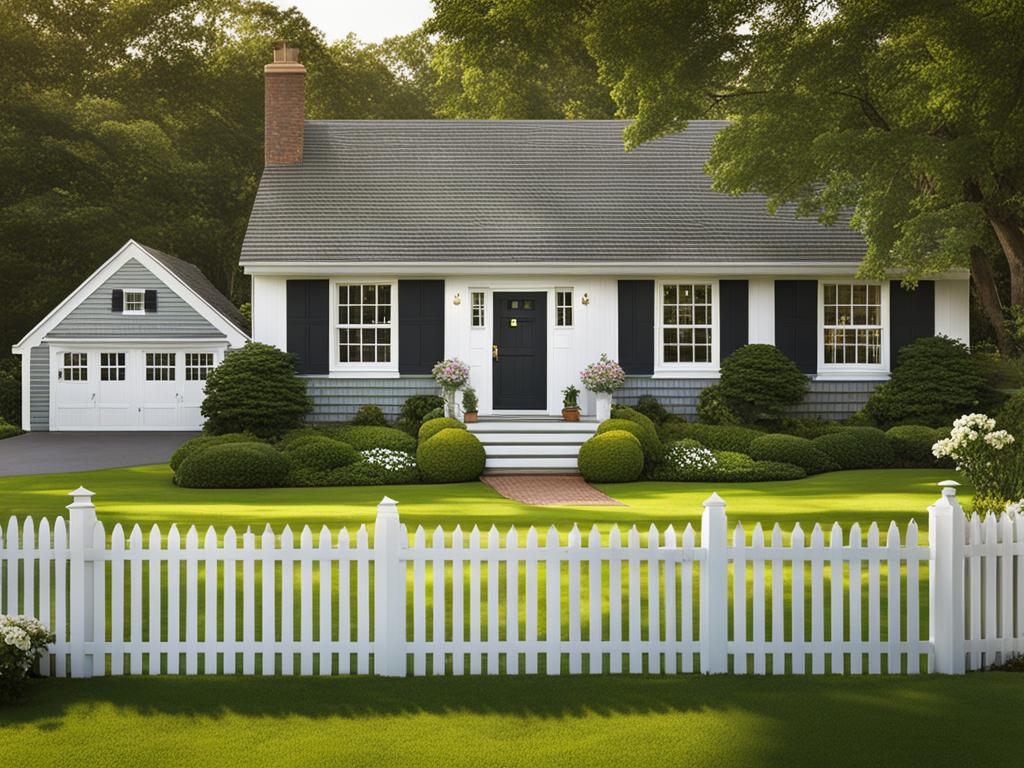
Distinctive Features of Cape Cod Homes
Cape Cod homes have several distinctive features that set them apart:
- A single-story design with a steep roofline
- A central chimney that serves as a focal point
- A symmetrical facade, often with a front door in the center and windows on either side
- Dormer windows that provide additional light and ventilation
- A cozy and inviting interior with a warm and charming atmosphere
The Influence of Colonial Revival
The Colonial Revival architectural style originated in the late 19th century as a nostalgic nod to the country’s colonial past. It was popularized by architectural enthusiasts who sought to recreate the elegance and simplicity of colonial homes. Cape Cod homes, with their central chimney and symmetrical facade, are a prime example of this revivalist movement.
Cape Cod homes represent the essence of early American architecture. Their classic design and timeless appeal continue to capture the hearts of homeowners today.”
Modern Interpretations of Cape Cod Homes
While retaining their traditional charm, modern Cape Cod homes often incorporate contemporary elements to cater to the needs and preferences of today’s homeowners. These updates may include open floor plans, larger windows for increased natural light, and updated interior finishes.
The Allure of Cape Cod Homes
Cape Cod homes hold a special place in the hearts of homeowners due to their rich history and enduring appeal. Whether nestled in a seaside community or situated in a suburban neighborhood, these homes evoke a sense of tranquility and nostalgia. Their clean lines, cozy interiors, and classic architecture make them a beloved choice for those seeking a timeless, elegant, and comfortable living space.
Cape Cod Homes vs. Colonial Revival
| Cape Cod Homes | Colonial Revival |
|---|---|
| Single-story design | Can be multi-story |
| Steep roofline | Varies depending on specific style |
| Central chimney | May or may not have a central chimney |
| Symmetrical facade | Symmetrical or asymmetrical |
| Simple, understated exterior | May feature more elaborate architectural details |
American Colonial Homes: Historic Charm and Symmetry
American Colonial homes represent a significant era in US history, dating back to the Colonial period from the 1720s to the 1780s. These homes showcase a unique blend of historic charm, architectural elegance, and symmetrical design. The architectural characteristics of American Colonial homes evoke a sense of tradition, craftsmanship, and timeless beauty.
The hallmark of American Colonial homes is their steeply sloped roofs, which allow for efficient rainwater runoff and provide a striking visual element. The symmetrical design of these homes, characterized by balanced windows and entrances, creates a sense of harmony and order.
One of the notable features of American Colonial homes is their small-paned windows, often made of wavy glass. These windows reflect the materials and construction techniques prevalent during the Colonial era. The intricate craftsmanship of the small-paned windows adds to the overall aesthetic appeal of these historic homes.
Let’s explore the key architectural elements that define American Colonial homes:
1. Steep Roofs
The steep roofs of American Colonial homes serve both functional and aesthetic purposes. They efficiently shed rain and snow, while simultaneously adding a distinctive visual element to the homes’ exteriors. This architectural feature contributes to the overall charm and authenticity of American Colonial homes.
2. Symmetrical Design
The symmetrical design of American Colonial homes is a reflection of the desire for balance and order during the Colonial era. The facades of these homes typically have evenly spaced windows and entrances, creating a sense of harmony and proportion. This symmetrical layout is a defining characteristic of American Colonial architecture.
3. Rectangular Shape
American Colonial homes are predominantly rectangular in shape, reflecting the practicality and efficiency valued during the Colonial period. The rectangular footprint allows for functional and flexible interior layouts, accommodating the needs of the homeowners while maintaining the overall symmetry of the design.
4. Small-paned Windows
The small-paned windows of American Colonial homes add to their historic charm and architectural authenticity. These windows, often made of wavy glass, are a remnant of the craftsmanship and materials used during the Colonial era. The small panes create intricate patterns of light and shadow, enhancing the visual appeal of the homes.
American Colonial homes continue to captivate homeowners with their historic charm, symmetry, and architectural elegance. Whether preserved as historic landmarks or adapted for modern living, these homes provide a glimpse into the rich heritage of the United States.
Take a closer look at the unique features that define American Colonial homes in the following table:
| Architectural Feature | Description |
|---|---|
| Steep Roofs | Roofs with a steep slope, allowing efficient rainwater runoff and adding visual appeal. |
| Symmetrical Design | Evenly spaced windows and entrances, creating a balanced and harmonious facade. |
| Rectangular Shape | Predominantly rectangular footprint, reflecting practicality and efficient use of space. |
| Small-paned Windows | Windows with small panes, often made of wavy glass, embodying the craftsmanship of the Colonial period. |
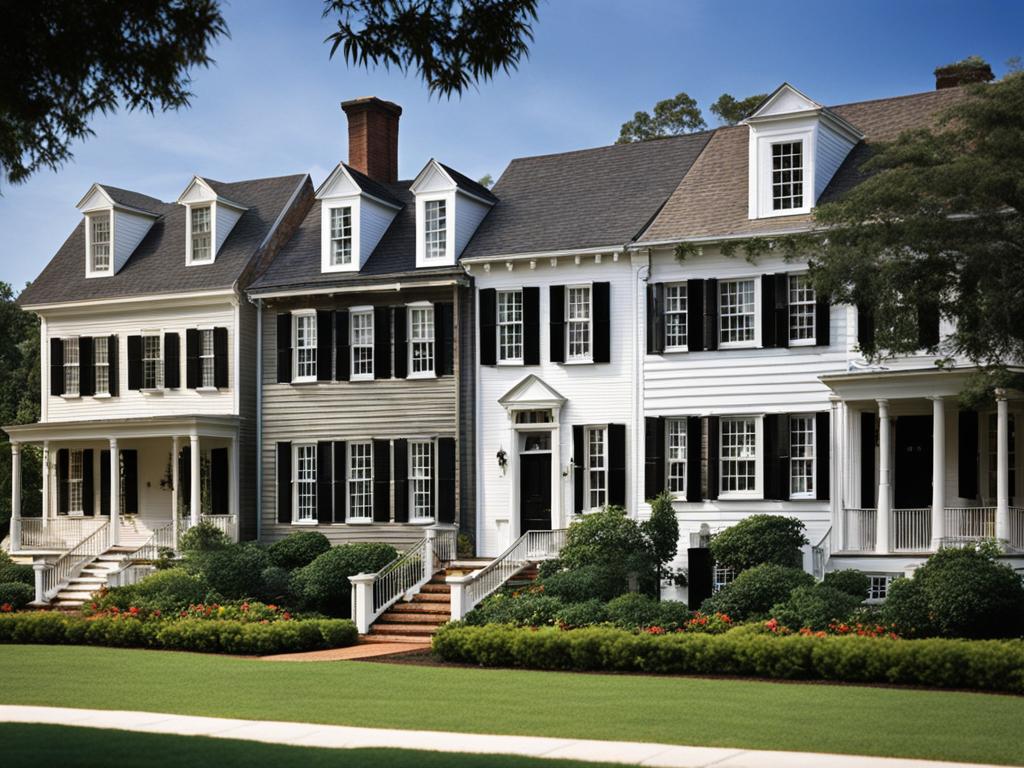
Colonial Revival Homes: Traditional Style with a Modern Twist
Colonial Revival homes draw inspiration from the 18th-century architectural style of the American Colonies. These homes pay homage to the past while incorporating modern design elements, creating a distinctive blend of tradition and innovation. What sets Colonial Revival homes apart is their symmetrical facades, attention to detail, and refined aesthetics.
Inspired by the elegance and charm of 18th-century design, Colonial Revival homes mimic the architectural elements of that period. These homes feature balanced proportions, with the placement of windows, doors, and other architectural details reflecting a sense of harmony and symmetry. The facades often showcase classical elements, such as columns, pediments, and grand entryways.
Colonial Revival homes also borrow elements from other architectural movements, infusing a touch of modernity into these traditional designs. For example, you may find influences from the Arts and Crafts movement or the Victorian era, adding ornate detailing or decorative patterns to the overall design.
The beauty of Colonial Revival homes lies in their ability to blend the old with the new. They capture the essence of the past while incorporating contemporary materials and features. This fusion creates a unique architectural style that appeals to homeowners seeking a traditional yet modern aesthetic.
Features of Colonial Revival Homes:
- Symmetrical facades with balanced proportions
- Classical elements such as columns, pediments, and grand entryways
- Attention to detail and refined craftsmanship
- Incorporation of modern design elements
- Harmonious placement of windows, doors, and architectural details
Colonial Revival homes offer a timeless and elegant living experience. With their combination of traditional style and modern twist, these homes continue to captivate homeowners looking for a harmonious blend of past and present.
| Pros | Cons |
|---|---|
| Classic and timeless design | May require regular maintenance |
| Elegant and refined aesthetics | May have limited floor plan options |
| Offers a sense of history and tradition | May be more expensive to build or renovate |
| Potential for increased property value | May not suit modern lifestyle preferences |
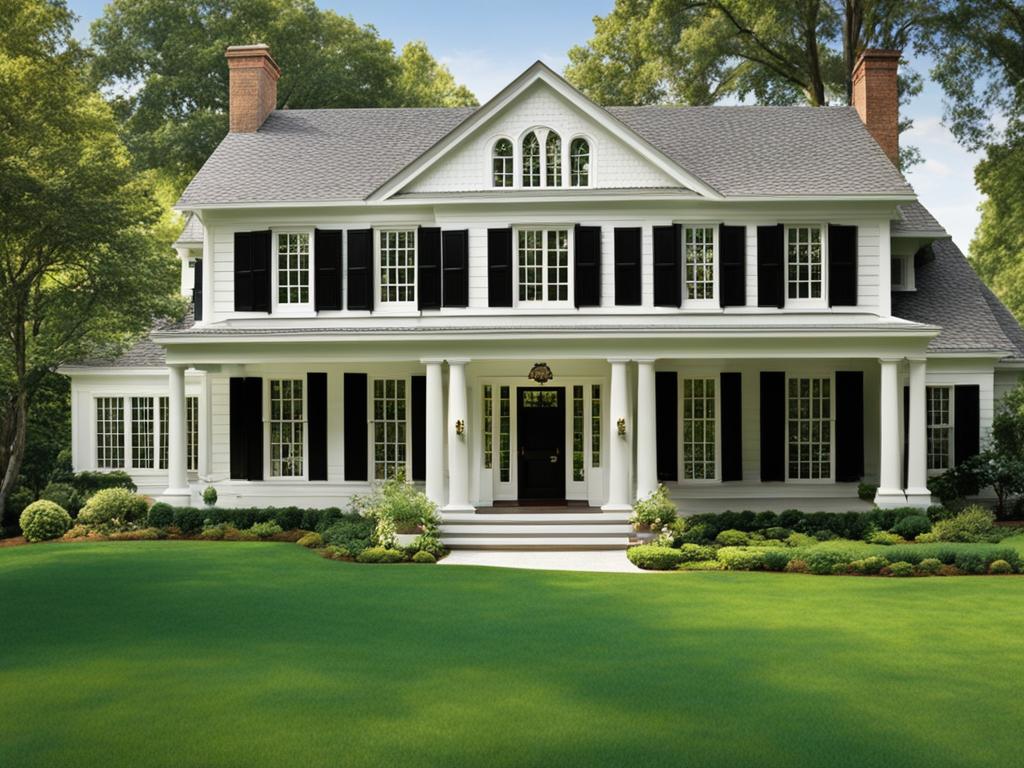
Colonial Revival homes continue to be a popular choice for homeowners seeking a blend of traditional elegance and modern comfort. Whether it’s the symmetrical facades or the attention to detail, these homes stand as a testament to the enduring appeal of 18th-century design.
Cottage Style Homes: Cozy and Charming Living Spaces
Cottage style homes offer a comfortable blend of modern and traditional elements. With their cozy and charming aesthetic, they provide homeowners with warm and inviting living spaces.
These homes typically feature small rooms that create an intimate atmosphere, perfect for relaxation and comfort. The use of dormer windows adds character to the exterior while allowing natural light to flood the interior, making the space feel bright and airy.
Porches are a common feature of cottage style homes, offering a welcoming outdoor space that encourages leisurely activities such as reading a book or enjoying a cup of tea.
Cottage style homes beautifully combine contemporary finishes and decorations with traditional architectural elements. The result is a modern-traditional blend that creates a unique and timeless appeal.
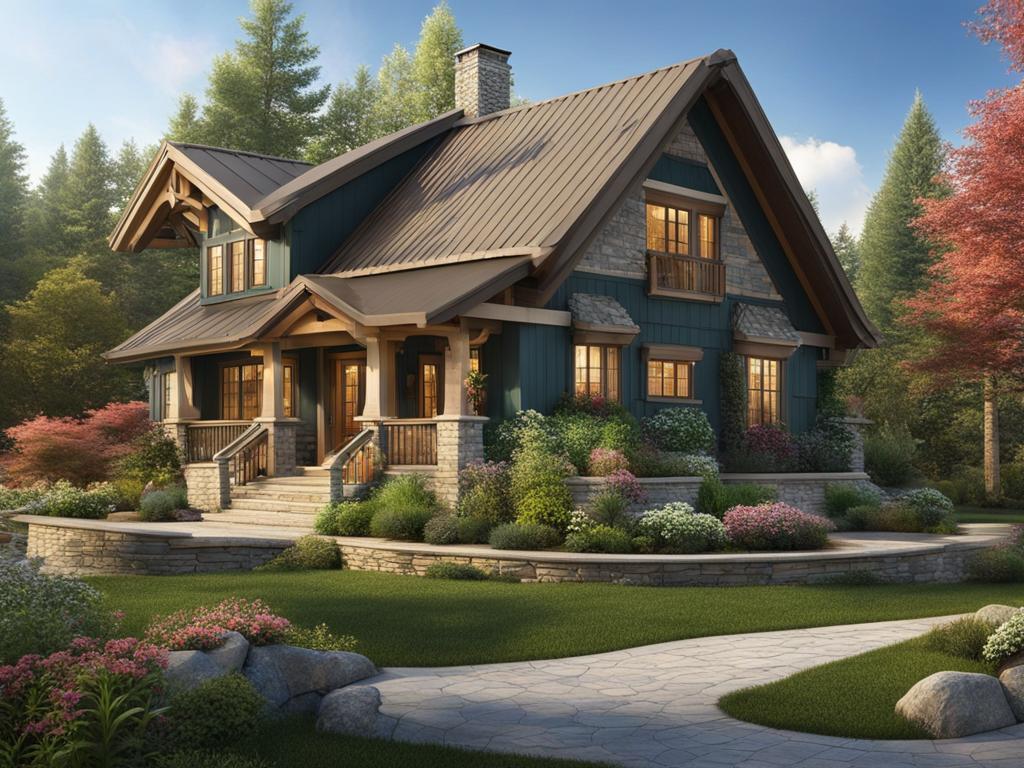
Creating a Cozy Atmosphere
To enhance the cozy ambiance of cottage style homes, homeowners often incorporate elements such as:
- Exposed wooden beams and plank ceilings
- Fireplaces or wood-burning stoves
- Soft and comfortable furnishings
- Warm color palettes
- Decorative wallpaper or textured walls
These design choices help to create a space that feels welcoming and snug, perfect for enjoying quality time with loved ones.
“Cottage style homes offer a retreat from the hustle and bustle of everyday life. With their cozy interiors and charming exteriors, they provide an oasis of relaxation and comfort.”
Embracing Nature
Cottage style homes often incorporate elements that embrace the beauty of nature:
- Large windows that offer panoramic views of the surrounding landscape
- Outdoor living spaces, such as gardens, patios, or decks
- Natural materials, such as stone or wood
- Flower boxes or window shutters that add a touch of whimsy
These features allow homeowners to connect with the outdoors and create a seamless transition between the interior and exterior spaces.
Modern Amenities with Vintage Charm
While cottage style homes evoke a sense of nostalgia, they are also equipped with modern amenities to meet the needs of contemporary living. Homeowners can enjoy the best of both worlds, combining the charm of a bygone era with the convenience of modern technology.
From updated kitchens with state-of-the-art appliances to luxurious bathrooms with spa-like features, cottage style homes seamlessly blend vintage charm with modern comforts.
| Traditional Elements | Modern Upgrades |
|---|---|
| Wooden floors | Underfloor heating |
| Clawfoot tubs | Walk-in showers |
| Antique chandeliers | Smart lighting systems |
| Exposed brick walls | Energy-efficient insulation |
These updates ensure that cottage style homes not only provide a charming living space but also cater to the needs and expectations of modern homeowners.
Whether nestled in the countryside or located in a suburban neighborhood, cottage style homes exude a sense of warmth, comfort, and timeless charm. They offer a retreat from the hectic pace of the outside world and provide homeowners with a cozy and inviting haven to call their own.
American Craftsman Homes: Artistic Design and Craftsman Influence
American Craftsman homes are a testament to the artistic design and influence of the Arts and Crafts movement, which flourished in the late 19th and early 20th centuries. These homes embody a unique blend of traditional craftsmanship and artistic elements, showcasing exceptional attention to detail.
One of the defining features of American Craftsman homes is their distinctive architectural design. These houses often boast gabled roofs, deep eaves, and exposed rafters, which not only add visual interest but also reflect the influence of the Arts and Crafts movement.
The Arts and Crafts movement was a reaction against mass production and industrialization. It emphasized the value of quality craftsmanship, handwork, and the natural beauty of materials. American Craftsman homes were built with an emphasis on manual labor, showcasing exquisite stonework, intricate woodwork, and other unique features that celebrated the artistry of the builders.
“Every house is a work of art, and every detail is an expression of the craftsman’s skill.”
The unique stone or woodwork found in American Craftsman homes is a hallmark of this architectural style. From exposed wooden beams to handcrafted cabinetry, these houses boast intricate details that showcase the mastery of the craftsmen who built them.
Furthermore, American Craftsman homes often feature open floor plans, allowing for flexible and functional living spaces. This architectural style prioritizes a seamless connection between indoor and outdoor environments, with elements like large windows and porches that bring the beauty of nature indoors.
Overall, American Craftsman homes represent a fusion of traditional and artistic elements, offering a unique and visually appealing style of western home design. They continue to captivate homeowners and admirers with their commitment to craftsmanship and attention to detail.
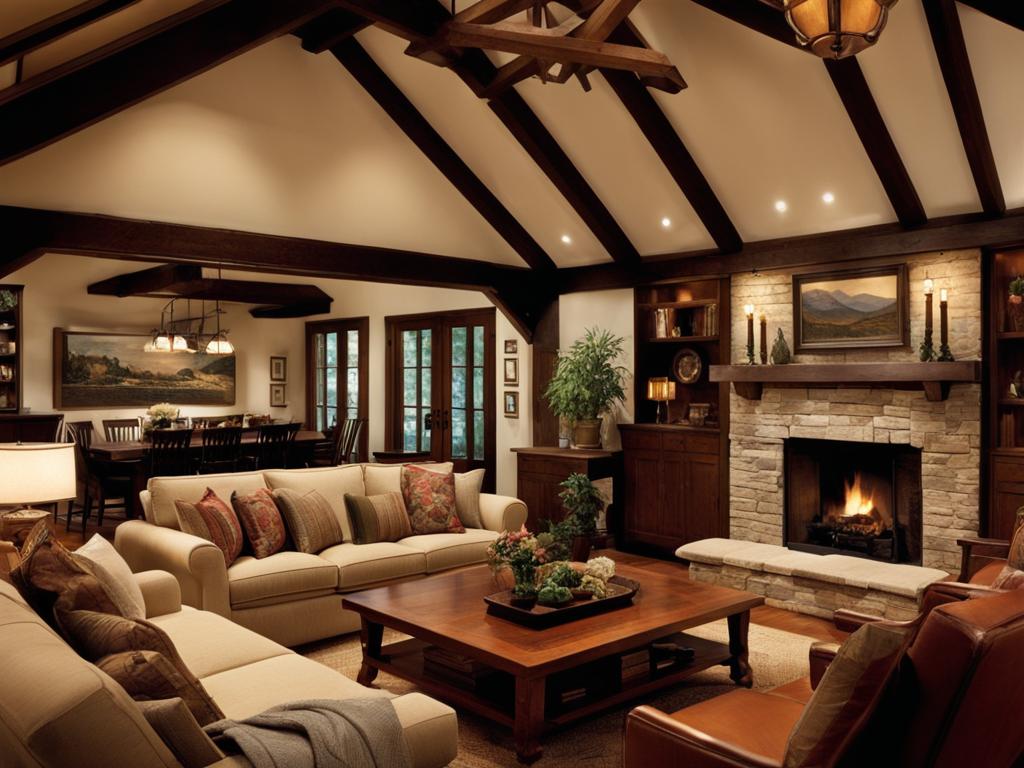
Benefits of American Craftsman Homes
- Unique and artistic architectural design
- Showcases exceptional craftsmanship and attention to detail
- Open floor plans for flexible and functional living spaces
- Seamless connection between indoor and outdoor environments
- Timeless aesthetic that continues to captivate homeowners
Farmhouse Style Homes: Classic Functionality and Rustic Appeal
Farmhouse style homes pay homage to the agricultural history of the United States. These homes capture the essence of country living and offer a welcoming and cozy atmosphere. With their classic functionality and rustic appeal, farmhouse style homes have become a popular choice for homeowners seeking a timeless design.
Symmetrical Facade for Balance and Charm
One of the defining features of farmhouse style homes is their symmetrical facade. This design element brings balance and charm to the exterior, creating an inviting and aesthetically pleasing look. The symmetrical layout typically includes a centered front entrance, flanked by evenly spaced windows on either side. This balanced arrangement reflects the simplicity and orderliness that is characteristic of farmhouse design.
Vertical-Hung Windows for Vintage Elegance
Vertical-hung windows are another hallmark of farmhouse style homes. These windows feature two separate sashes, with the top sash remaining stationary while the bottom sash can be raised or lowered. This traditional window style not only adds visual interest to the home’s facade but also allows for ample natural light and ventilation. The vintage elegance of vertical-hung windows perfectly complements the rustic charm of farmhouse design.
“Farmhouse style homes exude warmth and character, evoking a sense of nostalgia for simpler times. The symmetrical facade and vertical-hung windows are key elements that contribute to the overall appeal and authenticity of this architectural style.” – Jane Thompson, Architectural Historian
Along with their distinctive features, farmhouse style homes prioritize functionality and practicality. These homes are designed to accommodate the needs of a working farm and offer efficient layouts that maximize space and storage. The interiors often feature open floor plans, large kitchens, and gathering spaces that foster a sense of togetherness and hospitality.
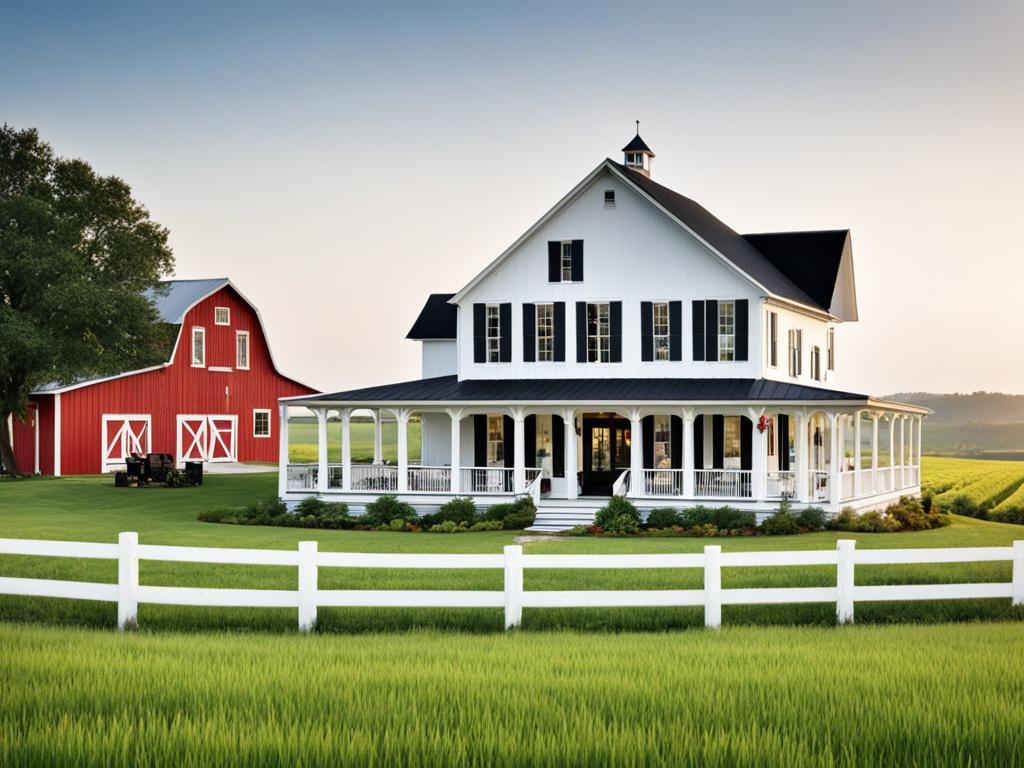
If you’re considering building or renovating a home in the farmhouse style, take inspiration from the timeless appeal of these classic designs. Embrace the symmetrical facade and vertical-hung windows to create a welcoming and authentic farmhouse aesthetic. Incorporate rustic materials and finishes, such as reclaimed wood and vintage fixtures, to enhance the overall charm and character of your farmhouse style home.
Modern Farmhouse Homes: Blending Rustic and Contemporary Elements
Modern farmhouse homes effortlessly merge the timeless charm of farmhouse style with the clean lines and modern aesthetics of contemporary design. These homes are designed to create a warm and inviting atmosphere while incorporating elements of rusticity and modernity.
One of the defining features of modern farmhouse homes is the use of rustic materials like wood and stone. These natural elements bring warmth and texture to the overall design, creating a cozy and inviting ambiance.
In addition to rustic materials, modern farmhouse homes also showcase sleek and modern lines. The combination of these contrasting elements adds depth and visual interest to the overall design, making it both timeless and contemporary.
Open floor plans are a common characteristic of modern farmhouse homes, allowing for seamless transitions between different living spaces. This open layout enhances the sense of spaciousness and flow, creating a welcoming environment for family and friends.
Large windows are also a prominent feature of modern farmhouse homes. These windows allow ample natural light to fill the interior space, creating a bright and airy atmosphere. The abundance of natural light further enhances the connection between the indoor and outdoor environments, bringing the beauty of nature inside.
Now let’s take a look at a comparison table showcasing the key features of modern farmhouse homes:
| Key Features | Modern Farmhouse Homes | Rustic Farmhouses | Contemporary Homes |
|---|---|---|---|
| Rustic Materials | ✓ | ✓ | ✕ |
| Modern Lines | ✓ | ✕ | ✓ |
| Open Floor Plans | ✓ | ✕ | ✓ |
| Large Windows | ✓ | ✕ | ✓ |
As depicted in the table above, modern farmhouse homes offer a unique blend of rustic and contemporary elements, setting them apart from traditional rustic farmhouses and purely contemporary homes.
Here’s a beautiful image showcasing the rustic charm and modern lines of a modern farmhouse home:
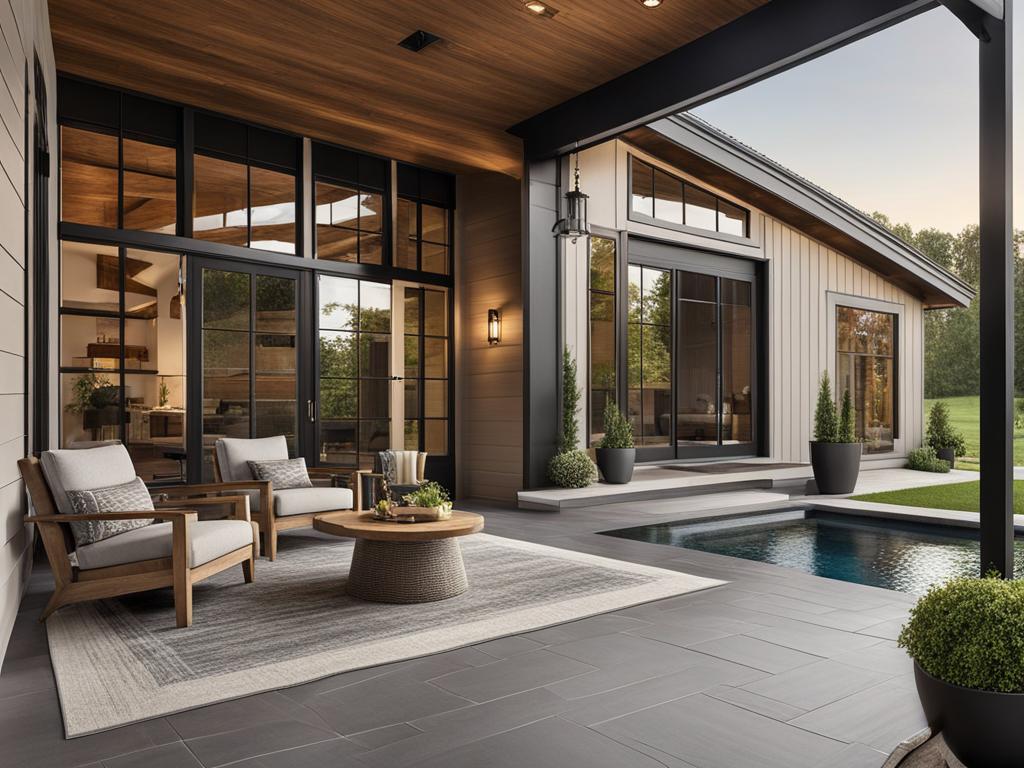
Inspired by the past but designed for modern living, modern farmhouse homes create a harmonious balance between rusticity and contemporary aesthetics. These homes offer a comfortable and stylish living space that embraces the best of both worlds.
Other Western Home Architectural Styles
In addition to the previously mentioned styles, there are several other architectural styles commonly found in western homes. Each of these styles offers its own unique features and characteristics, adding to the diverse landscape of western home design in the US.
French Provincial
The French Provincial style draws inspiration from the rural French countryside, reflecting a relaxed elegance and rustic charm. It emphasizes symmetry, delicate details, and a warm color palette. This style often incorporates ornate woodwork, curved lines, and decorative elements like wrought iron balconies and shutters.
Georgian
The Georgian style emerged during the reigns of King George I to George IV in Britain, and later influenced American architecture. Georgian homes are known for their symmetry, balanced proportions, and classical elements. They typically feature a formal facade, large windows with multiple panes, and a central front door adorned with decorative trim.
Gothic Revival
The Gothic Revival style became popular in the mid-19th century as a romantic revival of medieval architecture. Gothic Revival homes are characterized by their pointed arches, intricate tracery, and steeply pitched roofs. This style evokes a sense of drama and grandeur, often seen in churches, universities, and residential architecture.
Italianate
The Italianate style emerged in the mid-19th century, drawing inspiration from Italian Renaissance architecture. Italianate homes often feature a low-pitched roof with wide eaves, elaborate brackets, and tall windows. They exude elegance and sophistication with their decorative details, ornate cornices, and often incorporate balconies or verandas.
Midcentury Modern
Midcentury Modern homes gained popularity in the post-World War II era, emphasizing simplicity, clean lines, and functionality. They often feature large windows, open floor plans, and a seamless integration between indoors and outdoors. Midcentury Modern homes are characterized by their minimalist design, flat or low-pitched roofs, and a focus on natural materials.
Neoclassical
The Neoclassical style draws inspiration from ancient Greek and Roman architecture. Neoclassical homes are known for their symmetrical facade, grand columns, and elaborate ornamentation. This style exudes grandeur, with classical elements such as pediments, pilasters, and balustrades.
Prairie School
The Prairie School style emerged in the early 20th century as a response to the ornate Victorian architecture. Prairie School homes are characterized by their horizontal lines, low-pitched roofs, overhanging eaves, and integration with the surrounding landscape. They prioritize simplicity, functionality, and a close connection with nature.
Tudor Revival
The Tudor Revival style emerged in the late 19th and early 20th centuries, drawing inspiration from Tudor architecture in England. Tudor Revival homes are often recognized by their decorative half-timbering, steeply pitched roofs, and tall chimneys. This style exudes charm and character, with intricate details, leaded glass windows, and elaborate doorways.
| Architectural Style | Key Features |
|---|---|
| French Provincial | Relaxed elegance, symmetrical design, ornate woodwork, warm color palette |
| Georgian | Symmetry, classical elements, large windows with multiple panes |
| Gothic Revival | Pointed arches, intricate tracery, steeply pitched roofs |
| Italianate | Low-pitched roof, wide eaves, elaborate brackets, tall windows |
| Midcentury Modern | Simple lines, open floor plans, natural materials |
| Neoclassical | Symmetry, grand columns, elaborate ornamentation |
| Prairie School | Horizontal lines, low-pitched roofs, integration with landscape |
| Tudor Revival | Decorative half-timbering, steeply pitched roofs, tall chimneys |
Conclusion
In conclusion, western homes in the US offer a diverse range of unique architectural styles and trends that capture the essence of western living. From charming salt box houses along the New England coastline to modern farmhouse designs, there are endless possibilities for creating your dream western-style home.
Whether you prefer the rustic elegance of a farmhouse or the sleek simplicity of an A-frame, these unique styles provide a variety of options for homeowners seeking a distinct and personalized living space. The western home design landscape in the US is constantly evolving, with new trends emerging that blend classic elements with contemporary influences.
As you explore the different styles and trends in western homes, you’ll find inspiration to create a space that reflects your personal taste and lifestyle. Embrace the architectural diversity and let these unique styles guide you in designing a home that is truly one-of-a-kind. With western homes, you can infuse your living space with the charm, character, and individuality that are synonymous with the US.
FAQ
What are some unique styles of western homes in the US?
Some unique styles of western homes in the US include salt box houses, carriage houses, duplexes, Tudor style homes, brownstone townhouses, A-frame houses, Cape Cod homes, American Colonial homes, Colonial Revival homes, cottage style homes, American Craftsman homes, farmhouse style homes, modern farmhouse homes, and other architectural styles such as French Provincial, Georgian, Gothic Revival, Italianate, Midcentury Modern, Neoclassical, Prairie School, and Tudor Revival.
What are salt box houses?
Salt box houses are a distinctive style of western homes commonly found along the New England coastline. These houses are characterized by their sharply slanted gable roofs, with two stories in the front and one story in the back.
What are carriage houses?
Carriage houses are a type of western home commonly found in urban areas, often next to or attached to standard row houses. These houses were originally built as accommodations for horses and carriages by wealthy families. They are characterized by their oversized arched center doorways and elegant architectural details.
What are duplexes?
Duplexes are a type of western home that offers versatile living options. They are standard single-family homes that have been divided into two separate units. Each unit has its own entrance and is fully equipped as a single-family home. Duplexes are known for their symmetry and can also refer to a single apartment unit that spans two floors.
What are Tudor style homes?
Tudor style homes are easily recognizable by their distinctive features. They often have decorative half-timbering, which is a mock frame made of thin boards filled with stucco or stone. The rest of the exterior is typically brick, and the roof is steeply pitched with multiple overlapping front-facing gables.
What are brownstone townhouses?
Brownstone townhouses are a classic type of western home that is commonly seen in cities like New York City, Boston, Philadelphia, and Washington, D.C. These homes are named after the brown sandstone used to coat their exterior, which gives them a timeless and elegant appearance. Brownstones are often multi-story buildings with unique architectural details.
What are A-frame houses?
A-frame houses are characterized by their triangular silhouette, resembling the shape of a capital “A”. They are most commonly found in northern parts of the US, designed to easily shed snow and rain from their sloped roofs. A-frame houses have a modern and minimalist aesthetic, with some even available as prefab homes that can be assembled by homeowners.
What are Cape Cod homes?
Cape Cod homes are a standout example of Colonial Revival architecture in the US. These single-story houses feature a central chimney and a simple, symmetrical facade. Cape Cod homes have a rich history and are reminiscent of the colonial era. They embody a timeless and classic style that is still popular in suburbs across New England.
What are American Colonial homes?
American Colonial homes date back to the Colonial era in the US, from the 1720s to the 1780s. These historic homes feature steep roofs, symmetrical designs, and rectangular shapes. They often have small-paned windows made of wavy glass, representing the materials used during that time period. American Colonial homes exude historic charm and timeless elegance.
What are Colonial Revival homes?
Colonial Revival homes are inspired by the 18th-century architectural style of the American Colonies. They feature symmetrical facades and borrow elements from other architectural movements. Colonial Revival houses pay homage to the past while incorporating modern design elements. These homes are characterized by their attention to detail and symmetry, creating a traditional yet modern aesthetic.
What are cottage style homes?
Cottage style homes offer a comfortable blend of modern and traditional elements. They typically feature small rooms, dormer windows, and porches, combined with contemporary finishes and decorations. Cottage style homes have a cozy and charming aesthetic, providing homeowners with a warm and inviting living space.
What are American Craftsman homes?
American Craftsman homes are closely associated with the Arts and Crafts movement of the late 19th and early 20th centuries. These homes incorporate gabled roofs, deep eaves, exposed rafters, and unique stone or woodwork. American Craftsman houses are known for their artistic design and attention to detail, reflecting the craftsmanship of the movement. They offer a blend of traditional and artistic elements in western home design.
What are farmhouse style homes?
Farmhouse style homes pay homage to the agricultural history of the United States. They feature a symmetrical facade, simple gabled roof, and vertical-hung windows. Farmhouse homes prioritize functionality and practicality, with a focus on simplicity and rustic charm. These homes capture the essence of country living and offer a welcoming and cozy atmosphere.
What are modern farmhouse homes?
Modern farmhouse homes combine the elements of farmhouse style with contemporary design. They feature rustic materials like wood and stone, paired with sleek and modern lines. These homes often incorporate open floor plans, large windows, and an infusion of natural light. The mix of rustic and contemporary elements creates a unique and stylish living space inspired by the past but designed for modern living.
What are other architectural styles commonly found in western homes?
Other architectural styles commonly found in western homes include French Provincial, Georgian, Gothic Revival, Italianate, Midcentury Modern, Neoclassical, Prairie School, and Tudor Revival. Each of these styles offers its own unique features and characteristics, adding to the diverse landscape of western home design in the US.

